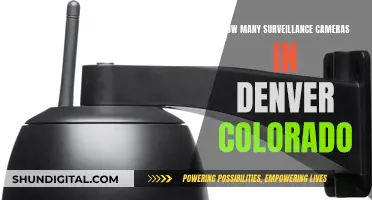
Rear cameras, also known as backup cameras, are now a standard feature in cars. Since May 2018, all new cars sold in the US have been required by law to be equipped with rearview monitoring technology. This law was implemented to address the blind spots that rearview mirrors can't see, enhancing safety and reducing the risk of accidents when reversing. While backup cameras offer many advantages, they should not be solely relied upon, as they may malfunction or be obscured by dirt or weather conditions.
| Characteristics | Values |
|---|---|
| What are backup cameras? | Video cameras attached to the rear of a vehicle to aid in reversing and reduce the rear blind spot. |
| When did backup cameras become mandatory? | In the United States, the requirement for backup cameras on new vehicles was introduced by the National Highway Traffic Safety Administration (NHTSA) and became effective on May 1, 2018. |
| Which vehicles need to have backup cameras? | The requirement for backup cameras typically applies to new passenger vehicles, trucks, buses, and multipurpose passenger vehicles with a gross vehicle weight rating (GVWR) of 10,000 pounds or less. |
| What are the benefits of backup cameras? | Increased safety, reduced risk of accidents while reversing, enhanced visibility of blind spots, improved awareness of obstacles, prevention of injuries or fatalities, and easier maneuvering in tight spaces. |
| Are rearview mirror cameras legal? | Rearview mirror cameras integrated into a vehicle's existing mirror or added as an accessory are legal in many states as they are considered safety devices. |
| Can you install a backup camera on a car that doesn't have one? | Yes, you can add a backup camera to older cars or vehicles built before the law went into effect. Aftermarket options are available, and some auto-parts retailers will handle the installation. |
What You'll Learn
- Backup cameras have been mandatory on all new cars sold in the US since May 2018
- Backup cameras can be added to older cars that don't have them
- Backup cameras are also known as rearview or reversing cameras
- Backup cameras can help prevent accidents and save lives, especially those of children
- Backup cameras can be combined with other features like parking sensors and automatic rear braking to further improve safety

Backup cameras have been mandatory on all new cars sold in the US since May 2018
Since May 2018, all new cars sold in the US have been required by law to have backup cameras. This regulation was implemented by the US Department of Transportation, and it applies to all cars coming off the production line. The requirement was first passed by Congress in 2008, but its full implementation was delayed for several years. Finally, in 2014, the Department of Transportation announced the effective date of May 2018, providing manufacturers with time to implement the technology.
Backup cameras, also called reversing or rear-view cameras, are video cameras attached to the rear of a vehicle. They aid in reversing and reduce the rear blind spot, which has been described as a "killing zone" due to the accidents it contributes to. The image captured by the camera is horizontally flipped to produce a mirror image, correcting the orientation for the driver. The camera is typically pointed at a downward angle to view potential obstacles on the ground, and it usually has a wide-angle or fish-eye lens to provide a comprehensive view.
The display for the backup camera is typically located in the center area of the cockpit, often using the existing screen for the entertainment system, climate control, navigation, and other functions. Some vehicles use a portion of the rearview mirror as a monitor, which has the advantage of being located where drivers are accustomed to looking when backing up. However, this type of monitor is smaller and provides a less detailed image.
The addition of backup cameras is expected to significantly reduce the number of injuries and deaths caused by backover crashes. According to the National Highway Traffic Safety Administration, in 2007, there were 221 fatalities and 14,000 injuries due to non-traffic backover crashes. Furthermore, according to the latest available government statistics, about 210 deaths and 15,000 injuries occur annually from backover accidents involving light vehicles, with 31% of those fatalities involving children under the age of five.
While backup cameras enhance safety, they are not a replacement for mirrors or physically turning around to look. Instead, they serve as an additional tool to reveal hidden dangers. It is important for drivers to use the cameras effectively and not solely rely on mirrors or their view out the back window.
Protecting Your Privacy: Securing Your Computer Camera
You may want to see also

Backup cameras can be added to older cars that don't have them
Since 2018, all new cars sold in the US have been required by law to have backup cameras. However, if you own an older car without this feature, you can still install a backup camera, also known as a rear-view or reversing camera, to improve safety and visibility.
Benefits of Backup Cameras
Backup cameras are designed to aid in reversing and reduce the rear blind spot, which has been described as a "killing zone" due to the accidents it contributes to. They can help avert injury-causing and potentially fatal accidents, particularly by expanding your field of vision below the rear window or trunk level. Cameras also increase your ability to see beyond the width of a mirror's image, helping to eliminate blind spots. Additionally, backup cameras can assist with parking, providing a clearer view of obstacles and warning tones when you're too close to an object.
Types of Backup Cameras
There are two main types of backup cameras available: wired and wireless. Wired cameras are integrated into the vehicle's infotainment screen or rearview mirror and typically cost between $200 and $500. Wireless cameras, on the other hand, are less expensive and easier to install, with prices ranging from $100 to $200. They are a good option for older vehicles that lack an infotainment screen.
Installation Process
The installation process for a backup camera can vary depending on the type of camera and your vehicle. Wireless cameras are generally simpler to install since they don't require drilling holes or splicing wires. Wired cameras may involve more labour and modifications to your vehicle, such as creating a mounting point for the camera and running wires through the vehicle.
If you prefer, you can also have a professional install the backup camera for you. Nationwide chains like Best Buy and Walmart offer installation services for approximately $130 to $140, excluding the cost of the camera.
Features to Consider
When choosing a backup camera, consider features such as reverse parking guidelines, which show the distance to objects behind you. Additionally, look for cameras with high-quality image resolution and good performance in both high and low-light situations.
Examples of Products
The Auto-Vox CS-2 is a wireless system that includes a mount for the rear license plate with a built-in camera. It is easy to install and costs around $120. For a more affordable option, the HD eRapta ERT01, available for around $25, offers a 4.5-star rating on Amazon, although it requires physical wiring into a power source. The Amtifo A1, priced at around $45, is another option that clips onto the rearview mirror and has a physical connection.
Mastering Camera Auto Focus: Calibration Techniques for Sharp Images
You may want to see also

Backup cameras are also known as rearview or reversing cameras
Backup cameras, also known as rearview or reversing cameras, are now standard in all cars and light trucks manufactured and sold in the US and Canada. This has been the case since May 2018, when it became a federal requirement. This mandate was driven by the need to address blind spots and improve rear visibility for drivers, thus reducing accidents and preventing injuries or fatalities. Backup cameras are designed to be attached to the rear of a vehicle, aiding in reversing and reducing the rear blind spot, which has been described as a "killing zone".
The image produced by a backup camera is a mirror image, horizontally flipped, so that the orientation is correct for the driver. This is necessary because the camera and the driver face opposite directions. The camera is typically pointed at a downward angle to view potential obstacles on the ground and utilizes a wide-angle or fish-eye lens to capture an uninterrupted horizontal path from one rear corner to the other.
Backup cameras are connected to the vehicle's head unit display, often using the dashboard screen that is also used for GPS navigation systems. When the transmission is set to reverse, the camera automatically activates and the backup view is displayed. Some systems also provide grid guidelines to aid the driver in parking.
While backup cameras have many advantages, they are not a perfect solution. Issues such as poor image quality due to a dirty lens or interference in wireless systems can affect their operation. Additionally, they should not be relied upon solely for reversing, as they may not always be functioning due to electrical issues or system malfunctions.
Prior to the 2018 mandate, backup cameras were available as standard or optional equipment in many vehicles. The first production automobile to incorporate a backup camera was the 1991 Toyota Soarer Limited, sold only in Japan. Since then, backup cameras have become increasingly common, with cameras available on roughly half of the vehicles sold in the US by 2015.
Charging Camera Batteries: A Step-by-Step Guide
You may want to see also

Backup cameras can help prevent accidents and save lives, especially those of children
Since 2018, backup cameras have been a legal requirement in all new vehicles sold in the United States and Canada. This legislation was implemented to reduce the number of accidents and fatalities caused by rear blind spots, which have been described as a "killing zone".
Backup cameras, or rear-view cameras, are video cameras attached to the rear of a vehicle, aiding reversing and reducing the rear blind spot. They are usually connected to the vehicle's head unit display, and some have a surround-view system, providing a top-down view of the vehicle and its surroundings. The image is horizontally flipped to produce a mirror image, which is necessary for the driver to correctly orientate themselves.
Backup cameras are particularly beneficial in preventing accidents and saving lives, especially those of children. They expand the driver's field of vision, eliminating blind spots, and increase visibility below the rear window or trunk level. This is crucial in detecting the presence of children, small animals, or objects such as toys, which may be difficult to spot with rearview mirrors alone. According to government statistics, approximately 210 deaths and 15,000 injuries occur annually from backover accidents involving light vehicles, with 31% of fatalities involving children under the age of five.
In addition to enhancing safety, backup cameras offer several advantages. They assist in parking by providing a clearer view of obstacles and warning tones when objects are nearby. They are also useful when towing a trailer, allowing drivers to see how it is lined up with the vehicle's hitch. Furthermore, backup cameras can help reduce minor accidents, saving money on repairs and insurance premiums.
While backup cameras provide numerous benefits, they should not be solely relied upon for safety. Drivers should also use mirrors and turn around to look, as recommended by the National Highway Traffic Safety Administration. Combining backup cameras with other safety features, such as rear parking sensors and automatic rear braking, can significantly enhance collision avoidance and further reduce the risk of injuries and fatalities.
Testing Camera Focus: Tips for Sharp Photography
You may want to see also

Backup cameras can be combined with other features like parking sensors and automatic rear braking to further improve safety
Since May 2018, all new vehicles sold in the US and Canada weighing less than 10,000 pounds have been legally required to be equipped with backup cameras. These cameras are designed to aid in reversing and reduce the rear blind spot, which has been described as a ""killing zone" due to the accidents it contributes to. While backup cameras offer many benefits, they can also be enhanced by combining them with other features such as parking sensors and automatic rear braking to further improve safety.
Parking sensors are a great addition to backup cameras as they provide an audible warning when the vehicle gets too close to an object. These sensors can be especially useful in urban settings or when backing out between two taller vehicles. When combined with a backup camera, parking sensors can reduce the backup collision rate by 42%. This is because the sensors provide an additional layer of warning, alerting the driver to potential obstacles that may be outside the camera's field of view.
Automatic rear braking takes this a step further by automatically applying the brakes to avoid a collision when the vehicle backs up. This feature is particularly useful when backing out of a parking space or driveway, as it can prevent accidents even if the driver does not respond to the warnings or look at the screen. When combined with a backup camera and parking sensors, automatic rear braking can lower the collision rate by up to 78%.
In addition to these features, some vehicles also offer a surround-view or bird's-eye view system, which uses multiple cameras to create a 360-degree view around the vehicle. This can be helpful when maneuvering in tight spaces and further reduces blind spots. Other technologies such as cross-traffic alert and forward collision warning can also enhance safety and provide drivers with a more comprehensive understanding of their surroundings.
While backup cameras and these additional features offer many benefits, it is important to remember that they do not replace the driver's responsibility to ensure the vehicle is clear before backing up. Drivers must still use their common sense and remain attentive to their surroundings. Additionally, factors such as rain, darkness, glare, and dirt on the camera lens can hinder the effectiveness of these systems.
A Year of Camera Tickets: How Many is Too Many?
You may want to see also
Frequently asked questions
Yes, as of May 2018, all new cars sold in the US are required by law to have backup cameras. This applies to vehicles weighing less than 10,000 pounds.
Backup cameras improve safety by reducing accidents and preventing injuries or fatalities when reversing. They also help eliminate blind spots, making it easier to manoeuvre in tight spaces.
Yes, you can install a backup camera in your car if it was built before the law came into effect in 2018. There are aftermarket options available for as little as $10.
Backup cameras are standard on all new cars sold in the US as of May 2018. However, this may vary by country and region, so it's best to check the specific regulations.







